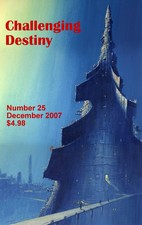


Reviews Home
Columns
Fiction by Title
Fiction by Author
Nonfiction
Movies by Title
Movies by Rating
Audio
Games
Beholder's Eye, Julie E. Czerneda, DAW, 1998, 413 pp.
Beholder's Eye is Czerneda's second book, and all of the strengths found in her debut (A Thousand Words for Stranger) are here in force. Strong characterization, engaging storyline, and nice use of narrative structure. As with her first book, Czerneda uses a somewhat fantastical premise for the main character, but then grounds that firmly in a more believable milieu. Here, the main character, Esen-Alit-Quar, is a shape-shifter, and some of the explanatory science seemed somewhat stretched to me. But Esen lives in a galactic future filled with more standard extrapolations, like first contact teams, the political entity known as the Commonwealth (a loose grouping of races, much like the Federation or Banks' Culture), and the shady underworld in most asteroid belts. One of the best aspects of Beholder's Eye is the various alien races that Czerneda develops, and then exploits fully in terms of narrative by letting Esen shift through those various alien shapes. Esen is not the perfect ethnologist -- too much compassion -- which of course makes for a more interesting character.
Esen is part of a Web, five similar shapeshifters who can share all memories. Esen is assigned the planet of Kraos as a starting task by Ersh, the Eldest shapeshifter. But once on Kraos, Esen becomes involved against a Kraosian plot to eliminate a First Contact team from the Commonwealth. While in the shape of a Lanivarian (a doglike race), Esen becomes friends with Ragem, a very perceptive Human. Esen's true nature is revealed, and Captain Kearn becomes obsessed with tracking down this threatening, evil creature. A parallel plot runs in the meantime, as a series of sections labelled "Out There" tells of an organism referred to only as Death or the Enemy. Death shows remarkable similarities to the shapeshifters of the Web, and some of the most interesting aspects of the novel come from the way Esen and friends try to differentiate themselves from this ravenous relative.
Czerneda has a knack for apt characterization. The minor characters are all well-written, even in small roles. For example, Kearn is perhaps a villain in the way that he obsessively misunderstands Esen's nature. But he is also credible in his actions, and his presence in the plot adds a nice wrinkle to the binary opposition between Death and Esen. The other members of the Web are portrayed with care, and each shapeshifter becomes important to the story in their own way. Skalet is impulsive and militaristic, Lesy is the sensualist, and Mixs the artist. Each of them fight the Enemy in their own way, which Esen and Ragem must take into account. Ersh is the Eldest and Ersh's personal saga is particularly interesting, especially in later revelations to Esen about the nature of the Enemy. The two main characters, Esen and Ragem, are the vital, beating heart of Beholder's Eye, and they are both quite fascinating. Ragem is Human, and he has been trained as a specialist in alien races and first contact. He gets lots of practice at this in dealing with Esen, but he is not perfect. In fact, his level of understanding is more remarkable for its achievements than its flaws. Thankfully, Czerneda does not write a romance between these two characters -- several times, Esen mentions some insights into how biology dictates certain behaviours gained from shapeshifting. A Hollywood romance would be inappropriate, and Czerneda gives us a fascinating friendship instead.
Esen is the narrator of Beholder's Eye, which lets Czerneda avoid the gender problem altogether. The English language has no satisfying gender-neutral third-person singular pronoun, but that problem is eliminated by writing in first person. And the title itself points to importance of perspective, perspectives such as gender and species, the latter more acutely. Esen constantly deals with the limitations of each of the forms. The Lanivarian form is how Lesy gave birth to Esen, so that is the form Esen finds most comfortable. But Kearn has identified the evil Enemy as Esen in Lanivarian shape, so Esen spends most of the book in the shape of a different alien race, the Ket. The Ket focus on tactility shapes most of Esen's actions, from the small details to larger ways of thinking. For example, take this lovely little passage: "Three bottles of dle tea later, I was halfway through a Braille book (such a sensuous pleasure, reading), when the public address system announced a ship arrival" (162). The Ket are also extremely empathetic, with a strong urge to soothe stress in others through the art of massage. While taking the shape of a Ganthor, Esen has to deal with strong herd instinct. In the basic Web form, Esen has almost no sensory input, but can ascertain the nature of matter down to the level of atoms. But the obvious point of the novel is contained in the continuity of Esen as narrator: Esen's character remains recognizable throughout, and Esen remains responsible for all of his/her/its own actions, no matter the form or gender. Czerneda strikes a nice balance through this method.
Beholder's Eye is an easy read, perhaps deceptively so. Czerneda considers a number of issues, like biological determinism and first contact, in the course of a strong narrative. Her exposition is smooth, almost invisible, yet upon finishing the book, the reader has been taken along on an informative, fun ride. Good work all around.
Last modified: November 12, 1998
Copyright © 1998 by James Schellenberg (james@jschellenberg.com)

Buy back issues of Challenging Destiny online from:
For the latest information on availability: Where Can You Buy Challenging Destiny?